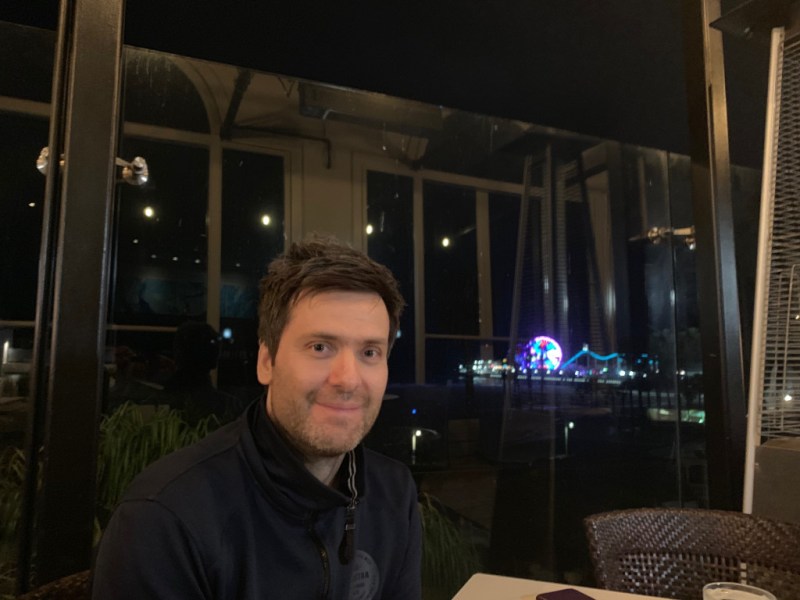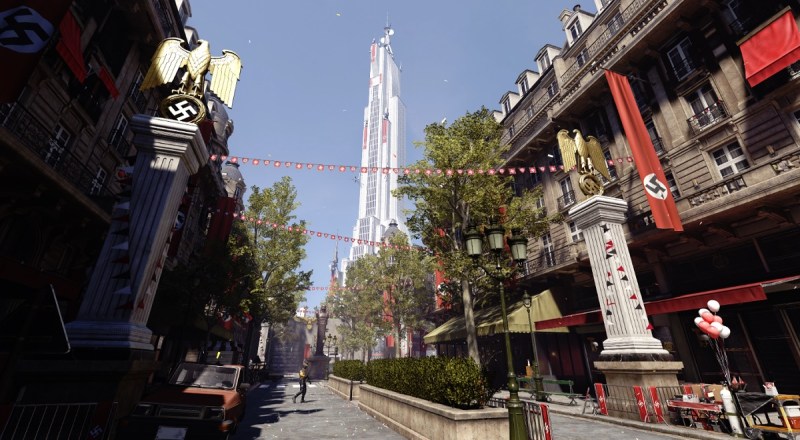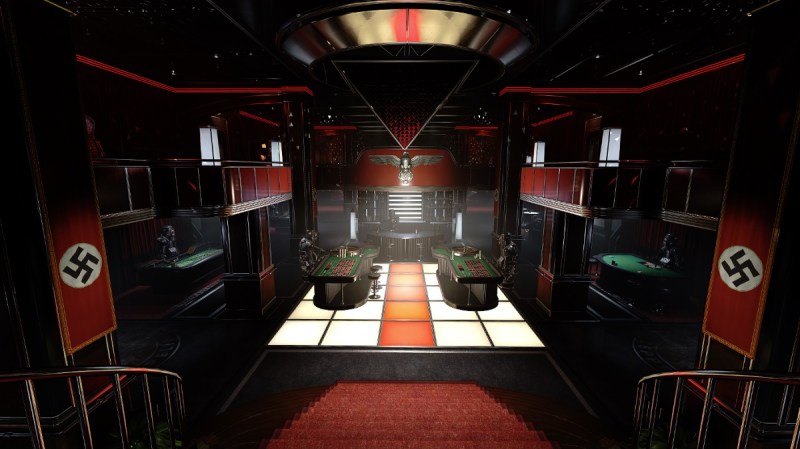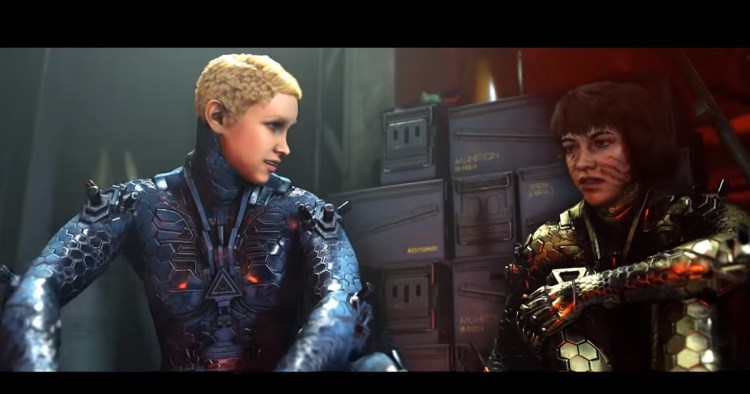Wolfenstein: Youngblood carries on the tradition of shooting video game Nazis as the latest two-player co-op shooter game coming from developers Machine Games and Arkane Studios Lyon, with Bethesda publishing the title on July 26.
As BJ Blazkowicz, the hero of the previous two games, has gone missing in Paris, the task of kicking Nazi butt has fallen to a new generation. This title has something earlier games did not have: a swastika in the German version of the game, as well as the global one. Germany changed its laws to allow the use of swastikas in art for educational purposes.
The series, which includes the great Wolfenstein: The New Order, and Wolfenstein 2: The New Colossus, takes place in an alternate history where the Nazis won World War II. The story in the previous game showed the Nazis working hand-in-hand with the Ku Klux Klan to occupy the United States. It was a testosterone-charged series, but now it features Sophia and Jessica, the twin daughters of BJ Blazkowicz.
I’ve played demos of the game, and it has a lighter tone as the goofy daughters banter with each other. While Blazkowicz’s father was abusive, the daughters have grown up in a loving environment. They’ve been trained to kill Nazis, but they do it in style, in a world that is largely free of serious political commentary.
June 5th: The AI Audit in NYC
Join us next week in NYC to engage with top executive leaders, delving into strategies for auditing AI models to ensure fairness, optimal performance, and ethical compliance across diverse organizations. Secure your attendance for this exclusive invite-only event.
I spoke with Jerk Gustafsson, executive producer of Wolfenstein: Youngblood, about the humorous story and the political environment in the game.
The game will ship on July 26 on Windows, PlayStation 4, Xbox One, and the Nintendo Switch. It will debut later on Google Stadia.
Here’s an edited transcript of our interview.

Above: Jerk Gustafsson is executive producer of Wolfenstein: Youngblood.
GamesBeat: It must feel good to have the game going gold on schedule.
Jerk Gustafsson: As always, it’s a bit scary as well. Especially this time around, because we’ve done so many new things in this game. It’s a bit outside of our comfort zone. It’s also exciting to see how people react. I hope it will do well. We’re really happy with it.
GamesBeat: What are some of the risks you took on this game?
Gustafsson: It’s hard to say. You always take risks, because we always try to set the bar pretty high. That’s how game development always is. For this game, there are so many things we did that are different from our other titles. We’ve been doing heavily story-driven single-player games for almost 20 years. Doing a cooperative game, an online game, from the ground up is a big step for us, even though it’s just for two players. That’s one part of it. As you know, we also have a different progression system. We have a more open-ended mission structure. Quite a few things are different.
It’s a big change for the fans as well. This is the first game in the series where you don’t play as B.J., for example. I’m excited to see the reception on that side, playing as the sisters.
GamesBeat: I hear it’s about 25 to 30 hours?
Gustafsson: It’s a bit different, honestly. It’s a big game. I would actually say that in terms of gameplay it’s the biggest one we’ve done. But the campaign is a bit lighter, not only in content but also in tone. The overall gameplay experience is bigger, though. From what we’ve seen — mainly due to the branching system, the new level progression system — even when you’re playing through the campaign, from the beginning to the end of the story, some of our internal playthroughs have been longer. It’s a pretty big chunk of a game. I’m proud of the team that we’ve managed to put together so much content in what, for us, is an unusually — our development time is usually a lot longer, on our past titles.
But that’s about right. When it comes to doing all the missions and playing through all the content in the game, we’re close to 25 or 30 hours.

Above: Uh oh. Co-op makes taking down bosses a lot easier in Wolfenstein: Youngblood.
GamesBeat: If you look at the whole series, I thought your original Wolfenstein had some interesting insights for a Swedish studio to make about America, about how Nazism could thrive here. How do you think that backstory, that research — why do you think it resonated with people? It wasn’t necessarily an overtly political game, but it resonated with people as being very insightful.
Gustafsson: Yes, to some extent. It’s a bit weird for us as well, especially when we started work on The New Colossus, on the story side. That was directly after New Order, so we started work on that story in 2014. It was quite a lot of time before the game actually came out, and a lot of things happened in those years. In that game, we wanted to tell the story of B.J. growing up, his childhood. It was a very dark story, with his abusive father and dark themes in general. And at the same time we wanted to tell a story about what happened if the Nazis won the war and took over the U.S. Since that happened around that time, especially with Charlottesville, it came to a point where we got a lot of, especially with interviews and talking to media—it led to a lot more discussions around the political aspect of it than we anticipated when we set out to do the game. That took us a bit by surprise. But I wouldn’t say that that’s changed how we approach development and how we approach story in our games. For Youngblood as well, I don’t think anything we do in terms of story, how we present the Nazis in the game and how we tell a story about fighting them, has changed due to that. Wolfenstein is about fighting the Nazis, and in our version of Wolfenstein the Nazis have taken over the world. It’s basically a story about you being a protagonist fighting the evils in this world, and in our game that evil is represented by Hitler and Nazism.
It might be that it has changed? It’s very hard for me to say. But I don’t think so, not based on any political discussions after New Colossus.
GamesBeat: With Youngblood you had some insight into the political environment that the game was coming into. Did that affect how you thought about the story at all? Or is Youngblood really just an extension of the story that you already had going?
Gustafsson: That’s what I mean, actually. I don’t think we’ve changed how we set out to tell the story. We have our Wolfenstein timeline and lore that we’ve written down internally. We’re staying true to that. On some level it might have changed even though we don’t really think about it. It’s hard for me to say. There have been quite a lot of political discussions over the last two years, which is understandable given the situation in the world right now.
But for Youngblood — the difference here is that when we set out to tell the story of New Colossus, where the Nazis have taken over America, that whole story was about freedom, about liberating America from the Nazis. It was about telling the story of how B.J. grew up. The difference with Youngblood is we wanted to do something lighter. While B.J. was growing up with an abusive father and all this trauma from his childhood, the two sisters grew up in a loving family. The story of Youngblood is an extension of that. It’s about these two young women transitioning from adolescence to adulthood. Their father has gone missing and they want to find their father, out of love. It’s much more of a story about not only the relationship between the sisters and their father, but also between the sisters themselves.
I don’t think it would have been so much different. But again, it’s very hard to say. It might have been.

Above: Sophia (left) and Jessica are the daughters of BJ Blazkowicz in Wolfenstein: Youngblood.
GamesBeat: Do you think Youngblood will resonate with fans in the same way that the original did?
Gustafsson: I’m not sure. I hope there will be some things, of course, but I don’t think it will specifically fall into that political aspect. I hope it will be something that resonates when it comes to playing as a woman protagonist, which is something that we haven’t done before, and the sisterly bond that we’re trying to build into this experience, the determination of these girls going out to find their father. Hopefully something will come from that, on the more positive side.
GamesBeat: One surprise was that the German version is actually allowed to use Nazi symbolism now, after changes in the law. Did you still have to go to the trouble of preparing two different versions?
Gustafsson: Yes, we did. It does make for a lot of work, and we’ve always been happy to do that work, because we want as many players as possible to be able to play the game. We did that for Youngblood because we didn’t know for sure what the outcome of those discussions would be. At the same time, we’re very happy that the government has finally decided to approve the title for release in Germany. With that said, we do have both versions available in Germany. As a German player, you can play the international version as well, which is great.
GamesBeat: I know there’s no split-screen, because it’s hard to maintain a consistent framerate. If you eventually did a game like this on something like Stadia, would it be easier to do split-screen again?
Gustafsson: I hadn’t really thought of that, actually. It could be, if it’s server-based. It would take a lot of technical work to set that up either way. But we are doing a Stadia version of the game for later this year. On a personal note, I’m super excited about what the streaming services can bring to gaming in the future. We can see some cool things coming. Hopefully we can do interesting things like what you’re talking about for future games.

Above: Wolfenstein: Youngblood features cool armored suits.
GamesBeat: How does it look with raytracing support? Are there any scenes that look a lot more special when you can do realtime raytracing?
Gustafsson: We’re working together with Nvidia on that, but raytracing won’t be available at launch. The engineers at Nvidia are still hard at work getting that solution to look as good as possible for the game, and the date is still to be determined. But from what we’ve seen so far, it’ll be good.
GamesBeat: You have a Switch version as well now.
Gustafsson: I’m always impressed by the guys at Panic Button, that they can accomplish things like that. It’s a miracle. We’re pushing the engine pretty hard in this game. Of course we did that for New Colossus as well. These guys are magicians. It’s a great honor to be able to work with them. I’m very happy that we can get Youngblood on Switch.
GamesBeat: Is that going to be download-only still?
Gustafsson: Yes, it’s still download-only. It’ll also be released on July 26, but it’ll be download-only.

Above: Action! Wolfenstein: Youngblood has long cut scenes but plenty of action.
GamesBeat: How did you get the tone of the game right, trying to tell a lighter story around what’s still a serious subject?
Gustafsson: That’s really the goal that runs through all of the titles we’ve done, even going back to Riddick and the Darkness. Even though there have been a lot of heavy subjects in our storytelling at times, we always try to find a lot of humor in them. I know we’ve gotten some feedback over the years that the shifts in tone might be too extreme, but that’s the way we’ve always worked. We like to embrace those tonal shifts.
For Youngblood, like I said before, the foundation of the story is lighter, but you’ll still see those shifts in tone throughout the experience, especially when it comes to fitting that humor in. It’s important to mix the sometimes more exciting or horrific moments with lighter, humorous moments as well.
GamesBeat: How do you think players are going to do playing such a long game in co-op on mode? Do you expect that people will play all the way through together?
Gustafsson: I hope so. I think so, at least. Of course you can still continue to play alone if someone else drops out, but it’s always better to have the full experience together. Hopefully people will play it that way. We have a lot of systems going on in the background to make sure you can join at any time, even if you’re at a much lower level than the other person playing. We scale things based on your level. We’ve done a lot of work to make sure it’s easy to play together regardless of where you are in the game.
While we do save progression when you play together, if you drop out and start a new game yourself, you’ll still have that progression intact as you did with your co-op partner. We’ve done a lot of things like that to make it simple and easy to join each other. I hope people will play together, because that’s the experience that I prefer myself.
GamesBeat: What did you call the little thumbs-up move?
Gustafsson: That’s something that came from — in the beginning we were planning on doing these emotes, these animations that players could use. But I thought it would also be a good idea to add some gameplay functionality to them. Those animations turned into something that’s extremely useful in combat. It came out of long discussions we had internally about how we could make the second-to-second combat more co-op friendly, making sure that there were more co-op features in there that you could use to help each other out throughout the combat. Then we came up with the pep signals.
It’s fun to use them, because we had the opportunity add voices for the sisters when they do that as well, and when they receive them. We use them not only to help each other in gameplay, but also to continue the narrative and that feeling of a bond throughout the experience. I’m quite happy with how that turned out.

Above: Wolfenstein: Youngblood takes place in a world where the Nazis are being pushed back after winning WWII.
GamesBeat: You’re on a road towards multiplayer. Do you think that’s going to happen for you one of these days?
Gustafsson: We are talking about it, to be honest. But I don’t know about what shape or form it would be. This is the first time we’ve ever done anything online, especially from the ground up. We did have some poor attempts for Riddick and the Darkness back in those days, but this is the first game where we’ve really focused on it as Machine Games. We really enjoy playing co-op in this combat that we’ve been iterating on for so many years.
I’m pretty sure that whatever we do in the future, it will have an online component. You’ll be able to play it with your friends. But with that said, what I feel is equally important — a very important thing for me personally – a Machine Games title will always let you play solo. That’s an important thing for us. So I’m pretty sure it will be a combination.
GamesBeat: I got a look at Call of Duty: Modern Warfare recently, and the level of realistic violence in that game bothered me this time. It wasn’t as clear to me that it was just a regular game. It’s an interesting contrast to Wolfenstein, where — I think it’s because it’s a total fantasy, but it doesn’t bother me, the violence in it. It’s just part of the fantasy. I don’t know if you guys think about those kinds of things when you’re making your games, but I feel like there’s a difference between a game that’s a fantasy and a game that tries to be too real.
Gustafsson: I can understand that. Of course I can’t really speak for other game or other developers. I don’t know about their processes and what they’re thinking. But in my mind, especially when it comes to Wolfenstein, it’s always been a fantasy. It’s always been over the top. Part of those tonal shifts I was talking about—in one scene you can have some very loving moments, and then in the next scene you’re shooting the heads off Nazis. That’s something, like I said before, that we’ve tried to embrace.

Above: The environments of Wolfenstein: Youngblood.
But at the same time, we’re always talking about it. After doing this for so many years now, people are becoming parents. They’re getting older. We look at the violence in games and movies in different ways. We’ve started to talk about maybe adding settings where you can turn things off. We haven’t done anything to address that specific subject right now. We’ll continue to make the games we want to make. The Wolfenstein games, over the top as they are — that’s part of it. But for future titles we might consider doing something different. It’s at least something we’re thinking about.
GamesBeat: The ability to create realism is only going to get better and better, as we have new consoles and better PCs.
Gustafsson: Absolutely. When streaming services really take off and everything is run from supercomputers in a server farm, we’ll be able to push it even more. At that same time, we’ll also be able to reach a lot more players right through their TVs. You’ll be seeing the same kind of expansion. We’ll have to look at what we’re doing and try to be as responsible as possible. But at the same time, we’ll always focus on making great games.


